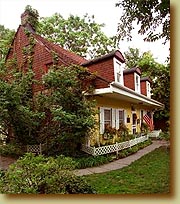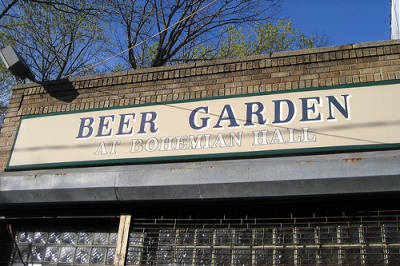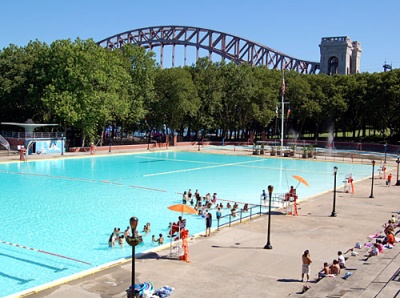Views
Creative Accent
Contents |
SS General Slocum
A steamship that took people around New York City was on the East River on June 15th 1904 when it caught fire, killing 1,021 people. It is New York's worst maritime disaster and was New York City's worst loss-of-life disaster until September 11th, 2001. The book, The Burning of General Slocum by Claude Rust, whose grandmother died on the ship, tells the story of the disaster. It was determined that the fire was started by a match that was tossed onto barrels of hay on the ship. As the flames engulfed the ship, the passengers died on the ship or drowned when they jumped into the East River. Two monuments are dedicated to the victims of the disaster, one in Manhattan and the other in Middle Village. There are only two survivors still alive today.[1]

The Riker-Lent Homestead
This is believed to be the oldest private home in America. It is a Dutch colonial farmhouse built by Abraham Lent around 1655. Although many confuse the address, 78-03 19th Road, with East Elmhurst or Jackson Heights, it is actually located in Ditmars (a section of Astoria). The Riker-Lent Homestead once included Rikers Island, which holds New York City's main jail (with 15,000 inmates). Rikers Island is now part of the Bronx, but the only way to get there is through the Rikers Island Bridge, which goes past the Homestead.[3]

Bohemian Hall and Beer Garden
Bohemian Hall and Beer Garden in Astoria is the last outdoors beer garden in New York City. The Bohemian Citizens' Benevolent Society (founded in 1892 to support Czech and Slovak families in Astoria[5]) bought two lots in 1910 and turned it into the beer garden.[6]

Astoria Pool
Astoria Park contains one of the largest and most popular pool complexes in the country. The Olympic-size pool and diving pool, as well as the wading pool, were built by Robert Moses in the summer of 1936. It was intended to be the greatest of the eleven pools built that summer in New York City (because it had the best view of the Triborough Bridge, also built that year), and it was used as a model for the other pools. Olympic Trials for the U.S. Swim and Diving Teams began in Astoria Pool the day the pool opened. Astoria Pool was used for the same purposes in 1964. Since then, it has encouraged community activities.[8]

Socrates Sculpture Park
In 1986, a group of artists and community members transformed the park from an abandoned riverside landfill and illegal dumpsite into an open studio and exhibition space for artists and a neighborhood park for local residents. "Socrates Sculpture Park is the only site in the New York Metropolitan area specifically dedicated to providing artists with opportunities to create and exhibit large-scale work in a unique environment that encourages strong interaction between artists, artworks and the public." Socrates Sculpture Park has received many awards, including the "Neighborhood Development Award for Outstanding Achievement in Community Development" in 2004 from the New York City Department of Small Business Services, and "Downstate Organization Award for Advancing Cultural Development in New York State" in 2003 from the by the Alliance of New York State Arts Organizations. In 2001, Socrates was named "Best Sculpture Park" by the Village Voice.[10]
The Queens Rainbow Community Center
The first lesbian, gay, bisexual, and transgendered community center in Queens, located at 30-74 Steinway Street, Astoria. The goal of the center is to generate understanding and tolerance of people of all sexual orientations.[11]
Celebrities
Singers Tony Bennett and Ethel Merman, actors Christopher Walken[12] and David Schwimmer,[13] four-time Olympic gold medalist (for discus throwing) Al Oerter,[14] and major-league baseball player Whitey Ford[15] are from Astoria. The television shows, All in the Family[16] and Cosby[17] were set in Astoria.
Return to Astoria or visit Astoria's Borders | Historic Overview | Immigrants in Astoria | Contemporary Profile | Testimonials of Residents
Citations
- ↑ http://www.newsday.com/community/guide/lihistory/ny-history-hs743a,0,7616452.story
- ↑ http://www.general-slocum.com/webimages/SlocumStartofTripNorthr.jpg
- ↑ Gryvatz Copquin, Claudia. The Neighborhoods of Queens. New Haven: Yale University Press, 2007.
- ↑ http://newsday.image2.trb.com/nynews/media/photo/2003-10/9644274.jpg
- ↑ http://www.bohemianhall.com/society.htm
- ↑ http://www.nyc.com/bars_clubs_music/bohemian_hall__beer_garden.53126/editorial_review.aspx
- ↑ http://farm1.static.flickr.com/217/469161333_94002100a6.jpg
- ↑ http://www.nycgovparks.org/sub_your_park/historical_signs/hs_historical_sign.php?id=8892
- ↑ http://z.about.com/d/queens/1/0/B/A/astoria-pool.jpg
- ↑ http://www.socratessculpturepark.org/History/History.htm
- ↑ Gryvatz Copquin, Claudia. The Neighborhoods of Queens. New Haven: Yale University Press, 2007.
- ↑ Gryvatz Copquin, Claudia. The Neighborhoods of Queens. New Haven: Yale University Press, 2007.
- ↑ http://www.sidereel.com/David_Schwimmer
- ↑ "Al Oerter." Encyclopædia Britannica. 2009. Encyclopædia Britannica Online. 11 Apr. 2009 <http://www.britannica.com/EBchecked/topic/425512/Al-Oerter>.
- ↑ http://www.nytimes.com/2000/08/17/sports/on-baseball-ford-highlight-film-started-early.html
- ↑ http://www.bbc.co.uk/dna/h2g2/A1076780
- ↑ http://www.imdb.com/title/tt0115144/